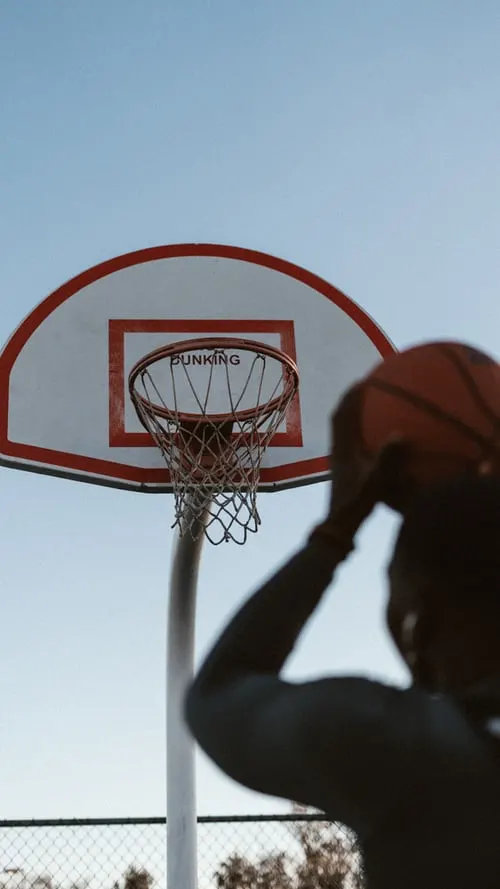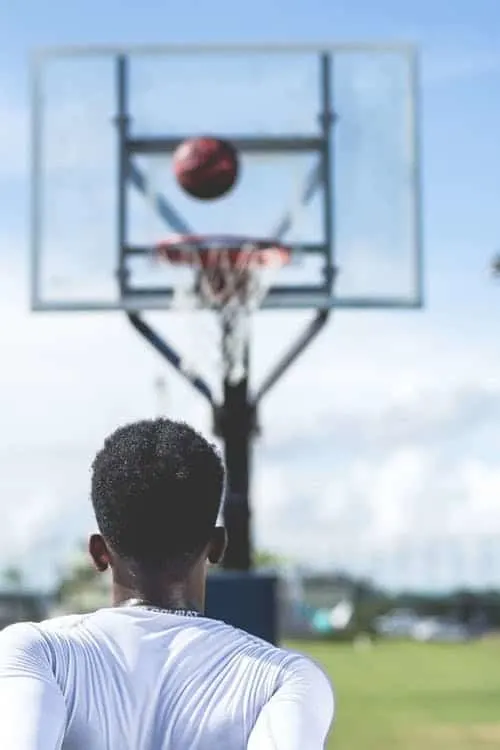Rebounding your own missed free-throw, when can you do it? Before or after the basketball hits the rim? Such a rule has confused me over the years playing basketball in 3 different levels and leagues governing rules differently. How can you blame me? I also watch the NBA, NCAA and I play men’s league that uses FIBA rules.
When can you rebound your own missed free-throw in basketball? In order to rebound your own missed shot you must wait for the basketball to hit any part of the goal first and or the rim. This is consistent in the NBA, NCAA, and high school basketball, men’s and women’s leagues. FIBA rules allow for the shooter to rebound their own missed free throw immediately after releasing the basketball.
Each league seems to have similar but also different rules when it comes to basketball and it can be confusing making it difficult to remember what the rule is for free throws. Let’s take a look at the rules of rebounding the basketball at the free-throw line and its violations.
If you are thinking about buying a basketball jersey or shoes, check out the offers below from these retailers.
| Retailer | Promo Code | Promotion | Link to Retailer |
 | DROP | 70% OFF | Go to Fanatics |
 | PARSCR20 | 20% OFF | Go to Eastbay |
 | N/A | N/A | Go to Amazon |

When can you rebound a missed free throw?
In every basketball league, the rules are universal for where players should line up to rebound a free throw. The players are allowed to move and attempt to rebound the basketball when the free-throw shooter at the line releases the ball from their hands or fingertips.
Differences in Freethrow Rebounding Across Each League
In the NBA, NCAA, and High School they must wait till the basketball touches any part of the basket but it must include the rim. Failure to hit the rim will result in a violation, think of an airball. The ball will be inbounded on the side out.
FIBA allows the free throw shooter to rebound their free throw immediately after releasing the ball. While some may feel like this is an advantage as the shooter should know better than anyone else where the ball is going when they release it.
With 3 players rebounding on each team including the free-throw shooter, the defense has the advantage based on the position below as they are closer to the basket. This is where the advantage really is, very rarely do offensive rebounds occur at the free-throw line.

What are the lane violations when it comes to shooting and rebounding free throws in basketball?
The definition of violation is basically a turnover in possession usually against the team with the ball. Free throw violations don’t occur often but when they do it results in a turnover in possession and sometimes with the basket not being counted. Or the shooter receives another shot because the opposing team was in violation and the shooter missed in the process.
It is also important to note if both teams commit a violation at the same time the ball goes to the arrow or jump ball, which is usually inbounded on the sideline. Some other things to keep in mind is when the shooter makes the shot and there is a violation from the opposing team the play continues. If there is a double violation and the shooter makes the shot the play continues also.

Some of the violations are as follows:
Shooter
- The shooter has 10 seconds to shoot the free-throw as soon as they are handed the basketball to the referee.
- The shooter may not step over the line until the basketball touches the rim. (FIBA rules exempt this rule)
- The shooter may not purposely pump fake a free throw.
Rebounder
- Must line up in one of the 3 lanes on either the left or right side of the hoop accordingly.
- May not distract the shooter when they have the ball and are ready to shoot.
- May not attempt to leave the lane until the basketball leaves the shooter’s hand.
- May not touch the rim, backboard goal or basketball to disrupt the shot.

How do free throws work?
When a player is fouled within the three-point line, they will be awarded 2 free throws if they missed the basket. On the first free throw, everyone finds a spot on the right or left side of the basketball hoop outside the key in a lane marked by lines dividing the players when rebounding.
In the NBA, NCAA, FIBA, and high school basketball the team that is shooting free throws may have up to 2 players rebounding the shot. While the opposing team who fouled the shooter may have up to 3 players in the NBA, NCAA and FIBA> In high school it is up to 4 rebounders
The player is awarded two shots, the first shot everyone relaxes and doesn’t move. On the second shot, the ball becomes live for any player to rebound when it is released from the player’s hand.
Keep in mind that if a player is fouled and makes the basket in the process, the basket will count towards the team’s current score and they will be awarded one free throw. If a player is fouled from the three-point line, that player is awarded 3 fouls and those players’ rebounding will relax for the first two shot attempts with the third attempt is being live.
So now that we know when the players lining up at the key can rebound a free throw, let’s take a look at when the free throw shooter can rebound their own missed free throw.

Why does the player shooting the free throw have to wait for the ball to hit the rim before rebounding?
The players lining up on the line who are attempting to rebound the missed shot by the free-throw shooter may do so as soon as the ball is released from the shooter’s hand.
But the shooter himself/herself must wait until the basketball hits the rim before attempting to rebound his/her missed shot. In failing to do so it’s a violation and results in a turnover in possession for the other team.
The rule is in place for the free-throw shooter to not gain an advantage for the player to miss the shot on purpose and gain his/her own rebound. This is why players rebounding the shot have the opportunity to gain possession of the basketball before the shooter does.
Could you imagine a Shaq or Chamberlain who were notoriously bad free-throw shooters missing on purpose, well they didn’t have to try to miss they were awful at the line. But could you imagine them missing and towering over everyone as soon as they released the basketball. That could pose as an advantage at the higher levels.
FIBA rules state that the free throw shooter may rebound as soon as it is released from their hand. You may think that this is an advantage in FIBA run leagues, but it’s not.
The reality is that it is very difficult to miss a shot on purpose and have the ball rebound directly back to you at the free-throw line. I say at the line because there will be players already in the key jockeying for position to get the ball. So good luck!